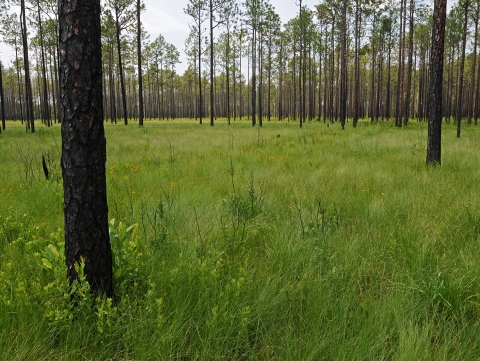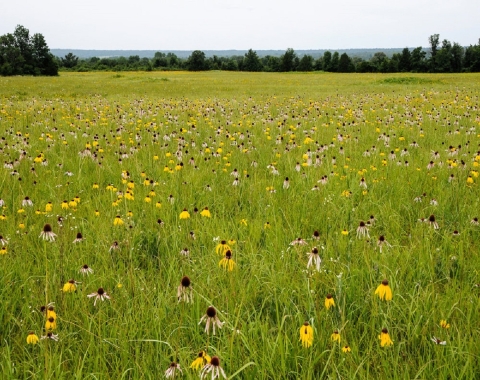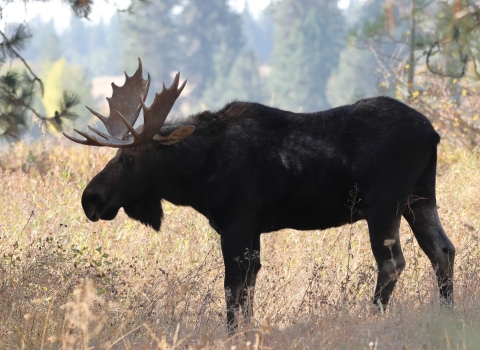Augusta, Arkansas - The old rice plantation isn’t much to look at to the untrained eye. It’s dinner-table flat with waist-high grasses and clumps of saltbush. A few young oaks sit, forlornly, in the middle of the 200-acre field. The bottomland forest lining the Cache River is a mile away.
To Richard Crossett, though, the so-called Howell Tract is beautiful. Crossett, you see, sees things differently. He’s a wildlife biologist with the U.S. Fish and Wildlife Service whose job is to restore the beaten-down rice field to its pre-agricultural splendor.
For the last eight years he’s managed the cutting, discing, burning and planting of the northeast Arkansas field with the goal of replicating the grassland ecosystem that once covered 100 million Southeastern acres. The grasslands were biologically rich ecosystems supporting all manner of bird, bug, flower and fauna. More than 90 percent of grasslands, though, have disappeared under the farmer’s plow and the builder’s bulldozer.
A return to the landscape of yore offers other benefits too. The Cache and Dale Bumpers White River national wildlife refuges are already world-renowned as migratory bird – ducks, in particular – hotspots. Recreating grasslands already pays dividends with the proliferation of other species too, including quail, doves and monarch butterflies. More grassland can only boost the refuge’s already renowned reputation for duck hunting.
“We’re trying to return this old farm land to the way it was 300 years ago,” said Crossett, the cold northern wind rustling the bluestem grasses and heralding the long-overdue arrival of ducks and geese. “Grassland habitat is very, very rare, so we’re promoting it for migratory birds, resident birds and a number of other species.”
Growing nation, shrinking grasslands
Southeastern grasslands once spread from Virginia to Texas, anywhere the tree canopy didn’t completely blot out the sun and grass could grow. They largely mimicked the longleaf pine savanna that covered 90 million acres throughout the coastal plain. But they also spread inland across portions of the Appalachians, Cumberland Plateau, and Arkansas’ Grand Prairie.
Think grasslands and most people picture the Great Plains, those treeless Midwestern expanses of tall, waving plants. In the Southeast, grasslands were found in savannahs, meadows, marshes, glades, fens and on mountaintop balds. Various grasses, flowers and bushes flourished. The grassy prairies were home to bison, northern bobwhite quail, monarch butterflies, and a slew of forb-dependent species.
“But look where we are today,” said Dwayne Estes, executive director of the Southern Grasslands Initiative housed at Austin Peay State University. “There’s been this wave of loss that progressed mostly from east to west, especially in the American interior, starting in the early 1700s. It is the most imperiled ecosystem in eastern North America.”
As the young nation grew, the rich, relatively flat prairies were logged and turned into corn, tobacco, cotton, peanut, rice and bean fields, as well as cattle pastures. Most of the eastern grasslands were gone by the Revolutionary War. The grassy plains of Tennessee, Kentucky, Alabama and Mississippi disappeared by the Civil War. Arkansas, Louisiana and Texas lost most of their grasslands a century ago.
As the young nation grew, the rich, relatively flat prairies were logged and turned into corn, tobacco, cotton, peanut, rice and bean fields, as well as cattle pastures. Most of the eastern grasslands were gone by the Revolutionary War. The grassy plains of Tennessee, Kentucky, Alabama and Mississippi disappeared by the Civil War. Arkansas, Louisiana and Texas lost most of their grasslands a century ago.
E.O. Wilson, the famed Alabama biologist, labels the Southern grasslands as “probably the richest terrestrial biome in all of North America.” Their fields were once carpeted with all manner of rare plants and grasses, including American chaffseed and smooth coneflower. Estes’ nonprofit reports that two-thirds of all rare plants in the Southeast require, or prefer, grasslands.
Today, only smallish remnants of grasslands exist primarily in fencerows, powerline corridors, roadway rights-of-way, and corners of old fields. Arkansas, at the time of the Louisiana Purchase, tallied a half-million acres of grassland. Today, maybe a few thousand acres remain.
“And we’re still losing acreage in places,” Estes said.
But not everywhere.
‘International importance’
Crossett drove the Service-issued F-150 to the other side of the Howell Tract, closer to Nubbin Ridge and the Cache River floodplain. A Northern harrier, with the face of an owl and the speed of a hawk, cruised low and fast looking for lunch in the scrub-shrub field.
“This grassland looks pretty good over here,” said Crossett, the biologist for the Central Arkansas National Wildlife Refuge Complex which includes the Cache River refuge. “It’s got a diversity of grasses and a lot of bare ground. And it’s not too dense, which is the way the quail like it.”
The U.S. Army Corps of Engineers wanted to dredge and straighten the Cache River in the 1970s to prevent flooding and boost irrigation. But Rex Hancock, a dentist and duck hunter from nearby Stuttgart, led a citizens’ protest against the river’s channelization and, eventually, succeeded in conserving much of the bottomland and floodplains. The Cache River refuge was established in 1986 and today tallies more than 73,000 acres.
Seventy miles of floodplain along the Cache and White rivers, as well as Bayou DeView, account for the one of the largest remaining tracts of contiguous bottomland, hardwood forest in North America. In 1990, the floodplain forest was recognized as a “Wetlands of International Importance,” a designation also bestowed upon the Florida Everglades, Chesapeake Bay and Okefenokee Swamp.
The region is also considered the most important wintering area in North America for mallards. Upward of a half-million migratory birds – mallards, Northern pintails, green-winged teal, gadwalls, American widgeons, snow geese – visit the Cache River refuge from late fall to early spring. Wood ducks hang out year-round.
Joseph Howell, the postmaster of the unincorporated town that bears his family’s name, owned the 3,500-acre rice and cotton farm that eventually became part of the Cache River refuge. In 2003, Howell “put” the farm into a U.S. Department of Agriculture program that protects and restores wetlands.
The Nature Conservancy bought the century-old farm a year later and began planting trees, oaks mostly, and restoring the land to a more natural state. The refuge acquired the farm in 2006. Crossett got busy.
There were competing, yet compatible priorities. Of foremost importance to the Service: a feeding and resting area for migrating waterfowl. TNC and other nonprofits want the land restored for the benefit of wildlife. The state of Arkansas emphasizes hunting with waterfowl a major draw.
Crossett has to balance the various demands with a fickle Mother Nature. Trees were cut, and new ones strategically planted. The fields were disced, both lightly and heavily. No more than 40 percent of the land was planted in grasses – Indian, little blue stem, millet and switch grass. Forbs, or flowering plants, provide food for birds and bugs, including pollinators; the bugs provide even more food for the birds.
The dove field required millet. Twenty acres of milkweed, sunflowers and coneflowers were planted for monarch butterflies and other pollinators. Prescribed fire is laid on the land every two or three years to invigorate forbs and grasses and keep the underbrush in check.
But how much fire, and at what time of year, is best? How moist should the fields be? Disc lightly? Heavily?
“It’s a learning experience to get the right mix of grasses and forbs,” Crossett said. “What’s the right balance of grasses and forbs? If the fields are too wet, you can’t disc or apply herbicides. If they’re too dry, you can’t burn ‘em. All of these factors have to be weighed.”
‘Top spot’
Slowly, the savannah grasslands have returned.
“There is a sense of accomplishment,” Crossett said as waves of snow geese – maybe 8,000 strong – rolled westward over the Howell Tract. “I’m proud that we were able to provide habitat for migratory birds and other native species. We couldn’t have done it without all of the assistance received from our partners.”
The U.S. Department of Agriculture, through its wetlands reserve program, covered the land clearing and planting costs. Quail Forever, a nonprofit, joined with the Arkansas Game and Fish Commission to enhance quail habitat and boost hunting on the refuge – the Howell Tract in particular. Northern bobwhite quail need that early successional habitat of grass, forbs, fire and cover to thrive.
“It’s now one of the top spots for quail hunting in the state because a lot of the habitat has been restored,” said Marcus Asher, quail program coordinator for Arkansas. “But the key is to get the state, the feds, nonprofits and private landowners to put together large, contiguous areas throughout the state.”
Restoring quail habitat benefits other species too. Migratory birds enjoy the same seeds and grasses. Doves, snipe, woodcocks, butterflies and raptors inhabit the same grasslands. Crossett says rabbits make up the second most popular hunted species on the Howell Tract. Frog giggers and deer hunters, too, prowl the wetlands. And, of course, humans visit the Howell Tract to eyeball all the wildlife.
“I’ve seen some of the biggest bucks in my life out here. And, duck-wise, it’s as good as any hundred-thousand dollar club,” said James Hatson, a hunter from nearby Heber Springs who was scouting the Howell Tract one recent Monday. “A lot of people didn’t know about hunting on the refuge. Now they do.”





